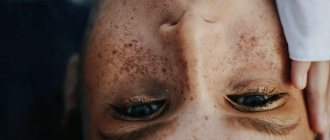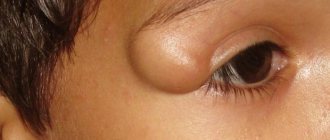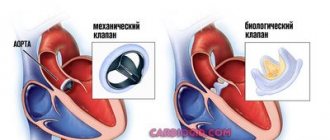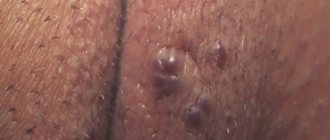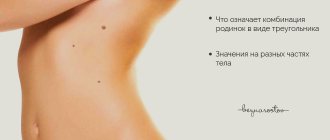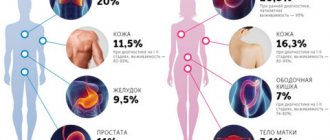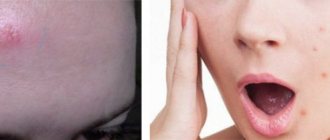A rash on the face in the area of the nose and lips often occurs in both women and men. But even if they do not look aesthetically pleasing, you should not squeeze pimples in the nasolabial triangle, for the reason that there is a very high risk of bacteria getting into the pores, causing complex inflammation of the skin. In most cases, acne around the lips and nose indicates some kind of internal disease. Mild forms of rash, such as comedones and papules, respond well to treatment with the right approach.
Kinds
Based on what factors triggered the formation of acne, acne can be divided into:
- infectious;
- non-infectious.
How to get rid of acne quickly
Acne is a common skin problem, affecting about 85 percent of the population.
According to the form of manifestation, they have the following varieties:
- rosacea – acne with a pinkish tint;
- herpes - watery contents are noted inside, located in most cases not only around the mouth, but also on the mucous membrane;
- perioral dermatitis - its symptoms resemble rosacea.
Regardless of the type of tumor, it is better not to try to get rid of the problem on your own, but to consult a specialist.
Historical reference
There are many historical examples when people, including very famous historical figures, died due to a squeezed out boil. Composer A. Scriabin died from a blood infection that resulted from a complication after a squeezed pimple.
The Queen of Württemberg, the granddaughter of Catherine the Great, independently squeezed out a pimple in the corner of her mouth, considering this a harmless action that would allow her to wake up as her former beauty. The next day, a tumor appeared in this place, excruciating pain, and the temperature rose. The royal person was not helped by any medical means of that time, and she soon died.
Causes
Acne can be caused by absolutely any factor. However, specialists were unable to fully identify the true causes of the rashes.
Acne around the mouth is caused by infection, toothpaste with fluoride, hormonal causes, contraceptives, and improper shaving in men.
Diagnosis is based on clinical and laboratory examination, examination and anamnesis. Treatment is appropriate to the causes of acne.
The following are common factors that can contribute to the formation of a rash in the area around the mouth:
- use of hormone-containing creams;
- use of decorative cosmetics (powder, foundation);
- exposure to low or high temperatures;
- brushing teeth with fluoride-containing toothpaste;
- increased activity of pathogenic microorganisms on the surface of the skin;
- hormonal imbalances ;
- complicated consequences as a result of past infectious diseases or colds;
- frequent use of oral contraceptives.
In women, the appearance of acne may be due to reasons such as changes in hormonal levels during the menstrual cycle or the development of certain diseases. In this case, the rashes are large and their location is single.
Pimples around the mouth in men (especially teenagers) appear due to ostiofolliculitis.
The reason is shaving the skin. In this case, it is better to replace the usual razor with an electric one to avoid injury to the epidermis.Then pathogens will not penetrate the skin and cause acne. It is recommended to use an antiseptic before and after shaving.
Cosmetologist, dermatovenerologist, laser therapist
Nachoeva Irina Nasredinovna
7 years experience
In the male half of the population, a rash in the mouth area occurs in most cases due to improper shaving or endocrine diseases.
How to get rid of acne marks
Facial rashes are a common problem that almost every person faces.
In addition to the above factors, acne can also appear for reasons such as:
- lack of compliance with hygiene rules ;
- poor nutrition;
- of vitamins and nutrients in the body
- pathologies of the gastrointestinal tract;
- using the wrong cosmetic product;
- bites ;
- various infections.
For treatment to be as effective as possible, it is necessary to determine the cause of the rash as accurately as possible.
Where is the triangle of death located?
The area on the face connecting the nose and the corners of the mouth is considered particularly vulnerable, as it is closely connected to our brain.
© Alliance Images
The best way to see the triangle is to form it with your fingers by connecting the tips of your thumbs and index fingers.
The tip of the triangle is the bridge of your nose, and its base starts at the corners of your mouth and extends to the contour of your upper lip.
Why is this area called the “triangle of death”? The fact is that the cavernous sinus
- a large vein that drains blood from the brain, creating a connection between the external and internal environment.
Symptoms
The following manifestations are characteristic of perioral dermatitis:
- inflammation of the skin in the lip area, which is accompanied by irritation and redness;
- multiple small pimples
- group rashes located close to each other;
- red tint of formations;
- peeling, burning and itching.
Subsequently, pigmentation occurs at the site of the skin lesion, which significantly spoils the aesthetic appearance and requires additional treatment.
When pathogenic microorganisms enter the layers of the epidermis, the rash becomes infectious. In most cases, perioral dermatitis is complicated by the addition of demodicosis. The presence of this disease will be indicated by ulcers formed in places of redness, the onset of the inflammatory process and severe itching.
Why can our articles be trusted?
We make health information clear, accessible and relevant.
- All articles are checked by practicing doctors.
- We take scientific literature and the latest research as a basis.
- We publish detailed articles that answer all questions.
In the presence of streptococcal infection, the patient experiences the appearance of watery pimples, which contain pus inside.
With non-infectious dermatitis, small red rashes form around the mouth. This type of pathology does not pose a health hazard, but still requires certain treatment.
If measures to get rid of the pathology are not taken in a timely manner, complications may arise in the form of a bacterial infection.
Varieties
There are different types of acne on the nasolabial folds:
Treatment for acne depends on the type and cause of its appearance.
Comedones. These are small black dots. They appear due to increased activity of the sebaceous glands when the pores become clogged. Over time, sebum oxidizes and turns black. Comedones can be closed or open.- Papules. Small blackheads with a white head that cause pain when pressed.
- Pustules. Medium-sized purulent rashes. They manifest themselves as painful sensations, itching and redness. To remove them, pulling agents or mechanical cleaning are used. Traces may remain after the pustule.
- Cystic acne. This is a severe form of rash in the form of large cysts. The formations are dense, painful, and very itchy. After the rash disappears, scars remain.
- Lightning rash. The rash appears due to a sudden decrease in immunity. Such acne is accompanied by fever and weakness.
Treatment
When the first signs of acne appear, it is not recommended to delay visiting a medical facility. If you can’t immediately see a dermatologist, experts advise starting with the zero therapy method, which will help prevent the development of more serious complications. The essence of such treatment is as follows:
Self-medication is dangerous with complications!
Attention
Despite the fact that our articles are based on trusted sources and have been tested by practicing doctors, the same symptoms can be signs of different diseases, and the disease may not proceed according to the textbook.
Pros of seeing a doctor:
- Only a specialist will prescribe suitable medications.
- Recovery will be easier and faster.
- The doctor will monitor the course of the disease and help avoid complications.
find a doctor
Do not try to treat yourself - consult a specialist.
- The first thing to do is to give up various skin care products, as well as decorative cosmetics.
- To brush your teeth, use toothpaste that does not contain fluoride.
- Do not take hormonal medications. If this is not possible, then you need to discuss options for replacing them with your doctor.
- Perform hygiene procedures daily. Use only warm water to wash your face. Perform actions at least twice a day.
- If possible, avoid touching your face with your hands, even if you have previously washed them with soap.
- Do not expose your skin to adverse factors such as wind, low or high temperatures.
It is also important not to squeeze pimples yourself. Wrong actions can provoke infection into the layers of the dermis, which is fraught with more serious consequences.
When visiting a doctor, after an examination and passing all the tests, the specialist, based on the results obtained, makes a final diagnosis, and based on this, selects the optimal treatment options.
Among medications, in most cases, drugs of the following groups are prescribed:
- Antihistamines.
- Vitamin complexes.
- Antibacterial - suitable for both internal and external use.
- Ointments with anti-inflammatory and antiseptic effects.
How to relieve acne inflammation
Acne is a widespread problem.
When diagnosing perioral dermatitis, antibiotic treatment is prescribed in most cases. These may be drugs:
- Local purpose - ointments. Their use is necessary first of all.
- Systemic action. Here, the leading positions are occupied by tetracycline drugs and macrolides.
In this case, as a rule, you should not expect a quick result. On the contrary, at the initial stage of therapeutic actions the situation is only complicated by an exacerbation, against the background of which an even more intense appearance of acne is noted.
Only after 14-21 days the severity of symptoms begins to decrease.
Complete cure occurs only after about twelve weeks of taking the drugs.
Diet
Proper nutrition plays an equally significant role. During treatment it is necessary to avoid such products as:
- roast;
- salty;
- spicy;
- bold
- alcohol;
- bakery,
The diet should contain only healthy foods, fresh fruits and vegetables, and the menu should also consist of foods of animal and plant origin.
Zonal risks
Such detail is extremely important to understand the potential danger of the nasolabial area. “The rich vascularization (good blood supply) of this area, anasomoses (connections) between the vessels sharply increase the risk of the spread of any infection. Hence the frightening name that this area of the face received for a reason, since the infectious process in a very short time can spread to the sinuses (sinuses), then the meninges can be involved in it, and meningitis develops,” emphasizes Tatyana Romanenko.
The therapist also notes that if the process progresses unfavorably, thrombosis may develop. “This is an extremely dangerous situation, very often leading to death. Therefore, the phrase “Don’t crush pimples!”, which everyone often heard in adolescence from their mothers and grandmothers, should be taken very seriously. Modern medicine has already learned to cope with acne, including those that form in the area of the nasolabial triangle, using effective and safe methods. The main thing is to see a doctor in time,” says Tatyana Romanenko.
Complications can also arise during cosmetic procedures, in particular contouring, says Tatyana Romanenko. “There are risks of compression or embolism of the inferior or superior labial arteries, which can lead to ischemia and/or necrosis of the tissue supplying this area,” the doctor emphasizes.
The therapist also says that one of the most formidable and dangerous complications is blindness as a result of embolism of the ophthalmic artery (a. ophthalmica). “Embolization of this artery can occur due to the introduction of an embolus in any part of the facial artery. If it gets into the bed of the facial artery and some of its branches, the embolus with blood flow can be delivered to the place of blood supply to the eyeball through the ophthalmic artery. Such cases are rare, but the existing risks cannot be underestimated. Remember that the face is our beauty and a high-danger zone, so all manipulations should be performed only by professionals, and cleanliness and proper care will help you avoid health problems,” notes Tatyana Romanenko.
Sew a young face. How is the popular thread lift applied? More details
Prevention
To prevent the appearance of acne around the mouth, it is important not to neglect the recommendations of specialists and follow them for preventive purposes. Basic Rules:
- Perform hygiene procedures regularly.
- Do not touch your face with unwashed hands, since it is pathogenic bacteria that cause the development of inflammatory processes.
- Wash your skin at least twice a day. In this case, you need to avoid using products that have a drying effect.
- After each use of products, cleanse the skin above the upper lip. Plain water or wet wipes are best for this.
- Include foods that contain large amounts of zinc and vitamin B
- Stick to the correct routine . Go to bed on time. You should get at least 8 hours of sleep at night.
- Do not expose the body to hypothermia or overheating. A sharp change in temperature also negatively affects the condition of the skin.
- Use slightly warm water to wash your face
If you follow all the recommendations and do them regularly, you can prevent the appearance of a rash. If this cannot be avoided, then it is better to seek help from a dermatologist, who will identify the cause of the rash and prescribe the correct treatment.
Photo: Nature of the rashes
The face is the first thing people look at when meeting someone. A rash on it causes trouble.
It is possible and necessary to treat acne, knowing the cause. Under no circumstances should you put pressure. The area where there is a nose, lip, chin is prohibited for this action. See how instaskin cream works against acne and blackheads. Causes of acne? Details in the article.
What is the best soap for acne? Read on.
Advice from a dermatologist, good products and a positive attitude will help you experience acne less often.
Squeezing out blackheads in other areas
You can squeeze out pimples on other parts of your face , such as your forehead or cheeks, but only in a dermatologist's office. The doctor himself will perform professional facial cleansing:
- mechanical;
- ultrasonic;
- chemical.
The doctor, based on the skin type and other characteristics of the body, will select the most effective method and carry out the manipulation in compliance with all sanitary standards. Only a professional can properly remove the pus so that it comes out completely and does not leak into the underlying tissues and bloodstream.
More and more Western dermatologists are abandoning the procedure of mechanical facial cleansing. It is believed that it is not only traumatic, but also ineffective. In addition, any manipulation that was performed incorrectly can lead to complications.
Possible complications
Before you start squeezing out pimples on your own, you should familiarize yourself with the list of complications that this is fraught with.
Independent actions to neutralize acne can lead to the following complications:
Hyperpigmentation. Due to damage to small capillaries and larger vessels, bluish spots appear.- Scars. Squeezing out purulent contents ruptures the subcutaneous epidermal layers. The wound heals and a scar forms.
- Infection. Under pressure, pus can seep into nearby pores. By squeezing one pimple, you can get an entire colony-settlement instead.
- Sepsis. After opening the pustules, the wound remains open. It can contain pathogenic bacteria. With the flow of blood and lymph, they begin their journey through the body, which can end in sepsis.
- Blood clot detachment. Microscopic particles of damaged tissue can get inside the capillary. There the clot will increase. In the event of an unfavorable combination of circumstances, such a blood clot can enter larger vessels and travel through the bloodstream to the brain or heart. So it turns out that squeezing a pimple can result in a heart attack or stroke.
If you can't, but really want to
There are few people so pedantic and careful who would go to the doctor to remove one pimple. Especially if the abscess was discovered on the eve of a birthday, wedding or other important event and you simply cannot get to the doctor.
In such an exceptional case, is it possible to squeeze them out? Acne is the only type of pimple that you can remove on your own. But subject to all precautions:
- Before starting the procedure, wash your hands thoroughly with soap;
- Then wash your face and steam the skin with a decoction of any medicinal herbs (St. John's wort, celandine, oak bark, string). If there are no herbs, you can simply sit, covering your head with a towel, over a bowl of boiling water.
- Wipe the area with the pimple with chlorhexidine;
- Wrap your index fingers in several layers of sterile bandage. You can use cotton pads;
- Using your index fingers, try to press on the root of the eel. This should be done carefully, without pressing the pimple inside;
- Squeeze out the pus until a drop of blood appears;
- Treat the wound with hydrogen peroxide;
- Apply a small piece of cotton wool moistened with salicylic acid to the wound for two to three minutes;
- Do not use decorative cosmetics for 48 hours after acne removal;
- A crust should form in place of the former pimple. You can’t rip it off; in a few days it will fall off on its own.
Traditional recipes for removing acne
You should squeeze out blackheads yourself only as a last resort. If the cause of their appearance is not identified and eliminated, they will appear again. Therefore, squeezing is not the most effective way to fight.
At home, you can use masks and scrubs. Scrubs are used only if there are no inflamed elements on the skin. A mixture of any anti-blackhead cleansing gel and fine salt and soda can effectively cleanse pores. Mix all ingredients by eye and treat problem areas twice a week.
A mask with egg white also effectively cleanses pores. Beat the egg whites with a mixer until foamy, then add a few drops of lemon juice. Apply to entire face for 15 minutes. A white clay mask with hydrogen peroxide gives good results. All you need to prepare it is mix the clay powder with peroxide until it reaches the consistency of sour cream. Apply to face and leave until completely dry. Then rinse with water and apply a pore-tightening cream.
The listed methods are completely unsuitable if there are red, purulent pimples on the face, especially boils. In order to safely get rid of such a pimple, it is better to purchase Vishnevsky or ichthyol ointment at the pharmacy. Apply the ointment directly to the inflammation, cover with a cotton pad and secure with a band-aid.
This compress can be left on all night. If you don’t need to go anywhere during the day, apply a compress for the day. Gradually the pus will come out completely without causing any harm.
Non-inflammatory acne in the nasolabial triangle
Non-inflammatory acne refers to small pimples, blackheads, and dark spots. Most cases are easily treated with over-the-counter (OTC) products. Medicated toners, creams, and spot treatments can help destroy bacteria, remove excess oil, and get rid of dry skin cells in the nose and lip areas.
Although products containing benzoyl peroxide may offer some benefits in treating acne, salicylic acid is more effective for this type of acne. Salicylic acid works by removing excess dead skin cells around the hair follicles in the nasolabial triangle, thereby destroying and preventing acne.
Alpha hydroxy acid (AHAs) exfoliants such as glycolic acid can unclog pores while reducing the appearance of age spots. Retinoids can also help by opening clogged pores in these areas of the face.
Prescription medications are not usually used for non-inflammatory acne.
Acne vulgaris and rosacea
Poll: When did your acne appear? (Number of votes: 4295)
I've been suffering all my life
It's been a couple of years now
About a few months
Recently
To vote, click on the desired answer. results
It's hard to tell the difference between acne vulgaris and acne rosacea because they have similar symptoms. They can also occur on the nose. However, these are two completely different types of acne.
Acne vulgaris is associated with pimples, blackheads, cysts and other forms of acne, while acne rosacea is a type of rosacea. It is also possible to have both acne vulgaris and acne rosacea at the same time.
The cause of Acne vulgaris or simple pimples on the nasolabial part of the face is clogged pores, which can be:
- pimples filled with pus;
- comedones;
- whiteheads.
Deeply clogged pores can cause cysts or pustules. Typically, these pimples are deeper, painful, and tender to the touch.
If you have acne on your nose, you may also have acne on other areas of your face, such as your chin and forehead.
In comparison, acne rosacea is primarily characterized by excessive redness and widespread swelling. These symptoms may start in the nose and spread to nearby areas of your face, such as the cheeks. Your nose may appear enlarged from inflammation, and pimples may eventually appear on top of the reddened skin. nasolabial triangle of the face.
